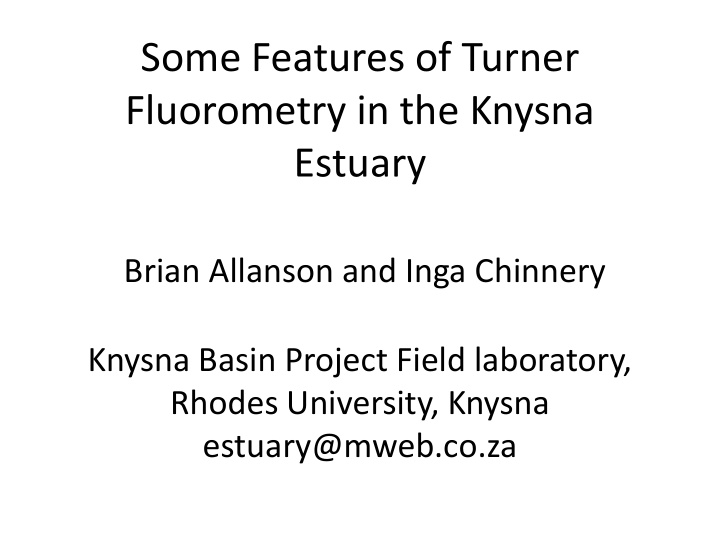



Some Features of Turner Fluorometry in the Knysna Estuary Brian Allanson and Inga Chinnery Knysna Basin Project Field laboratory, Rhodes University, Knysna estuary@mweb.co.za
Acknowledgements • Our thanks are due to: – Barloworld – Rhodes University – Marine remote sensing unit – SANhydro tides Tokai, Cape Town – MRSU 2012 – Joclyn Fearon
Figure 1. Marine Embayment, Knysna estuary
Figure 2. Turner submersible fluorometer: left hand downloading data mode; right had submersible mode with battery pack in place.
Figure 3a Knysna Estuary: Neap tide 14 – 17 Feb.2012 Water temperature °C 25 24 23 22 21 20 19
Figure 3b Chlorophyll a µg/l 3.5 3 2.5 2 1.5 1 0.5 0
Figure 3c Turbidity in NTU units 20 18 16 14 12 10 8 6 4 2 0
Figure 4a. Stn 2 Ashmead Channel Spring Tide, 7 – 13 .03. 12 Temperature °C
Figure 4b.Stn 2 Ashmead Channel Spring tide, 7 – 13.03.12 Chlorophyll a µg/l
Figure 4c. Stn 2 Ashmead Channel Turbidity as NTU, 7 – 13.03.12
Figure 5. Sea surface temperature (left) Chlorophyll a (right):15.01.12 Knysna marked by a black dot at 23 ° S
Figure 6. SST (left) and Chl a (right) 08.03 2012. Knysna lies at 23° South
References • Allanson & Reed 1995;Aminot & Rey 2000;Cloern & Jassby 2110;Grange & Allanson 1995;Litaker et al. 1987;Lucas 1986: MRSU 2012;Muir & Perissinotto 2011; Roegner & Shanks2001;Smith (2008)Kotsedi et al. 2012;Snow& Adams 2005;Trner Designs 2012;Vorwerk et al.2008.
Recommend
More recommend